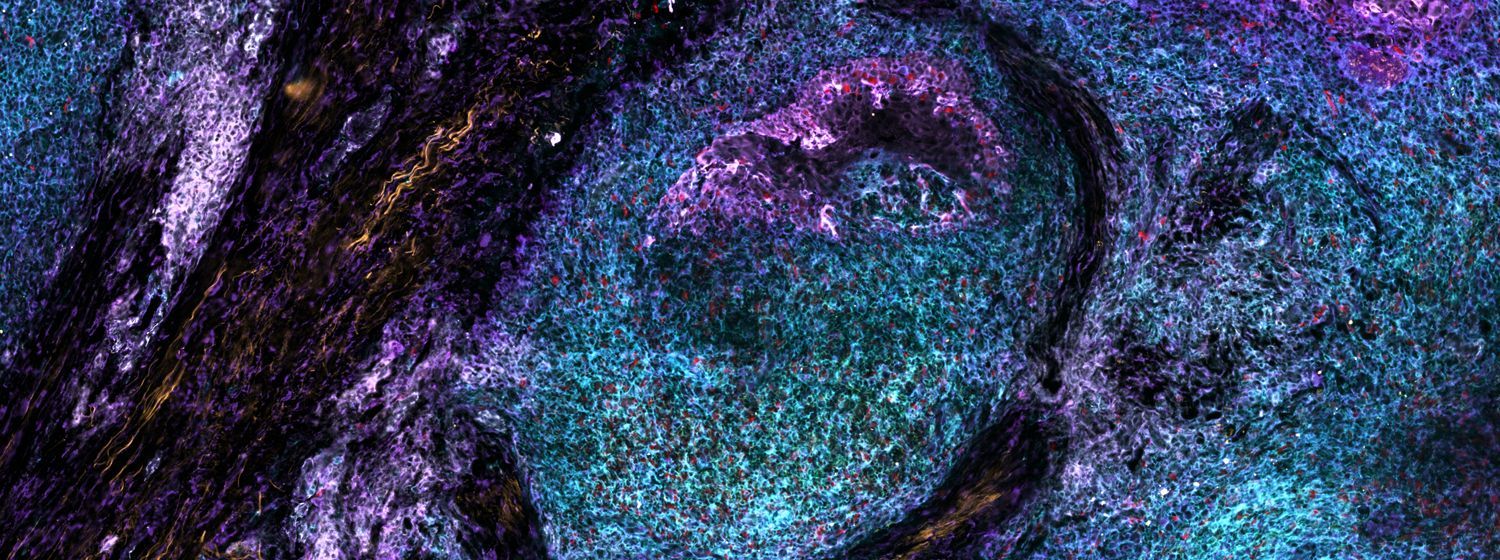Deciphering the hidden language of life
Next to machine learning, spatial omics is becoming one of the hottest topic in biotech!
Want a recap? Check out our latest blog explaining the ins and outs of spatial omics.Imagine a detailed map of a city, but instead of streets and buildings, it shows the activity and location of every single person. That's the power of spatial omics, and VIB researchers are at the forefront of this rapidly growing field. By analyzing molecules at their precise locations within tissues, we're gaining a whole new understanding of health and disease.
Traditionally, biology has focused on the average activity of genes or proteins within a cell population. But this flat picture misses crucial details. VIB researchers are increasingly using spatial omics to reveal how the location of molecules can dramatically affect their function.
Decoding disease with precision
In the fight against Alzheimer's disease, Bart De Strooper's team at the VIB-KU Leuven Center for Brain & Disease Research very recently used spatial omics to make an important discovery. They characterized the brain’s immune response to amyloid plaques, the hallmark clumps of protein associated with the disease. Their findings revealed that microglia, a type of immune cell, consistently congregated around the plaques, while another type of cell, astrocytes, showed variation across brain regions. This suggests that microglia disrupt the normal signaling between astrocytes and neurons, which could contribute to cognitive decline. This deeper understanding suggests new therapeutic avenues targeting the interplay between these cell types and their impact on neuronal signaling.
The power of spatial omics extends even further. Sarah-Maria Fendt’s lab at the VIB-KU Leuven Center for Cancer biology is exploring the potential of spatial metabolomics, the study of small metabolism-related molecules within tissues. Cancer cells are known to have different metabolic profiles compared to healthy cells. By using spatial metabolomics, the lab aims to identify the unique metabolic signatures of different cancer subtypes. Next stop? The discovery of new therapeutic targets that offer more precise and effective treatment options for cancer patients.
Our understanding of the liver is also being transformed by spatial omics. Group leaders Charlotte Scott and Martin Guilliams at the VIB-UGent Center for Inflammation Research pinpointed the specific cell types responsible for the difference between lean and fatty livers. Traditionally, fatty liver disease has been treated with a one-size-fits-all approach. However, spatial omics revealed that different cell types contribute to the disease, which might enable personalized therapies targeting these specific cell populations, offering a tailored approach to managing non-alcoholic fatty liver disease.
Don't miss Prof. Scott's talk on profiling hepatic macrophages at the upcoming Spatial Omics Conference!Unraveling biology
Stein Aerts's lab at the new VIB.AI Center for Computational Biology & AI is taking spatial omics one step further by using it to map gene activity differences within the liver. This has revealed a surprising level of spatial organization. Genes involved in different functions, like detoxification and fat metabolism, are clustered in specific areas of the liver. This hidden organization likely plays a crucial role in the overall health and functioning of the organ.

Plants are not left out of the spatial omics revolution! Tom Beeckman's group at the VIB-UGent Center for Plant Systems Biology pioneered spatial approaches to study plant roots. Their work provides new insights into how these vital organs interact with their environment, potentially leading to the development of a more sustainable agriculture.

Combining know-how
But groundbreaking discoveries require powerful tools. That's where Yvan Saeys' lab at the VIB-UGent Center for Inflammation Research comes in. They've developed cutting-edge analytical tools to help researchers across the globe make sense of the complex data generated by spatial omics experiments. Their user-friendly SpatialData platform allows researchers to visualize, analyze, and interpret their data.
Be sure to check out their poster at the Spatial Omics conference!Even more, with all this spatial omics expertise in different research areas, VIB has recently combined all its know-how in the Spatial Catalyst, part of VIB Technologies, which offers unique expertise in the field.
Evelien Van Hamme leads the Spatial Catalyst and explained it best in her latest interview: “We facilitate access to these technologies and provide support for data analysis – a significant bottleneck for researchers. By fostering collaborations and sharing expertise, we aim to empower researchers to leverage spatial omics effectively."
Want to leverage our know-how of Spatial Omics in your own research? Contact VIB Technologies.VIB's commitment to spatial omics research is revolutionizing our understanding of biology. From Alzheimer's to fatty liver disease, from plant roots to cancer treatment, these powerful techniques are giving us a whole new view on the variety and interaction of molecules within living organisms, ultimately leading to better treatments for a wide range of diseases and a deeper understanding of the natural world.
Want to be kept up-to-date on our biotechnological news and stories? Join our community and subscribe to our bi-monthly newsletter.
Between 13 and 14 June, VIB organizes the Spatial Omics conference in the beautiful city of Ghent, which will bring together experts from academia and industry to present their most recent discoveries.
India Jane Wise
Read more




